| THIS WEEK'S ARTICLES |
| The Mindful Investor with David Keller, CMT |
| Can the S&P 500 Move Meaningfully Higher Without NVDA? |
| by David Keller |
2024 has been a year marked by exceptional returns for a relatively small number of high-flying growth stocks. In recent weeks, top performers like Nvidia (NVDA) have pulled back, and Super Micro Computer (SMCI) remains well below its all-time high from earlier this year. So can the major equity benchmarks continue their Q2 strength if these stocks are not breaking out?
First, let's review the market conditions as defined by the performance of the S&P 500 index.
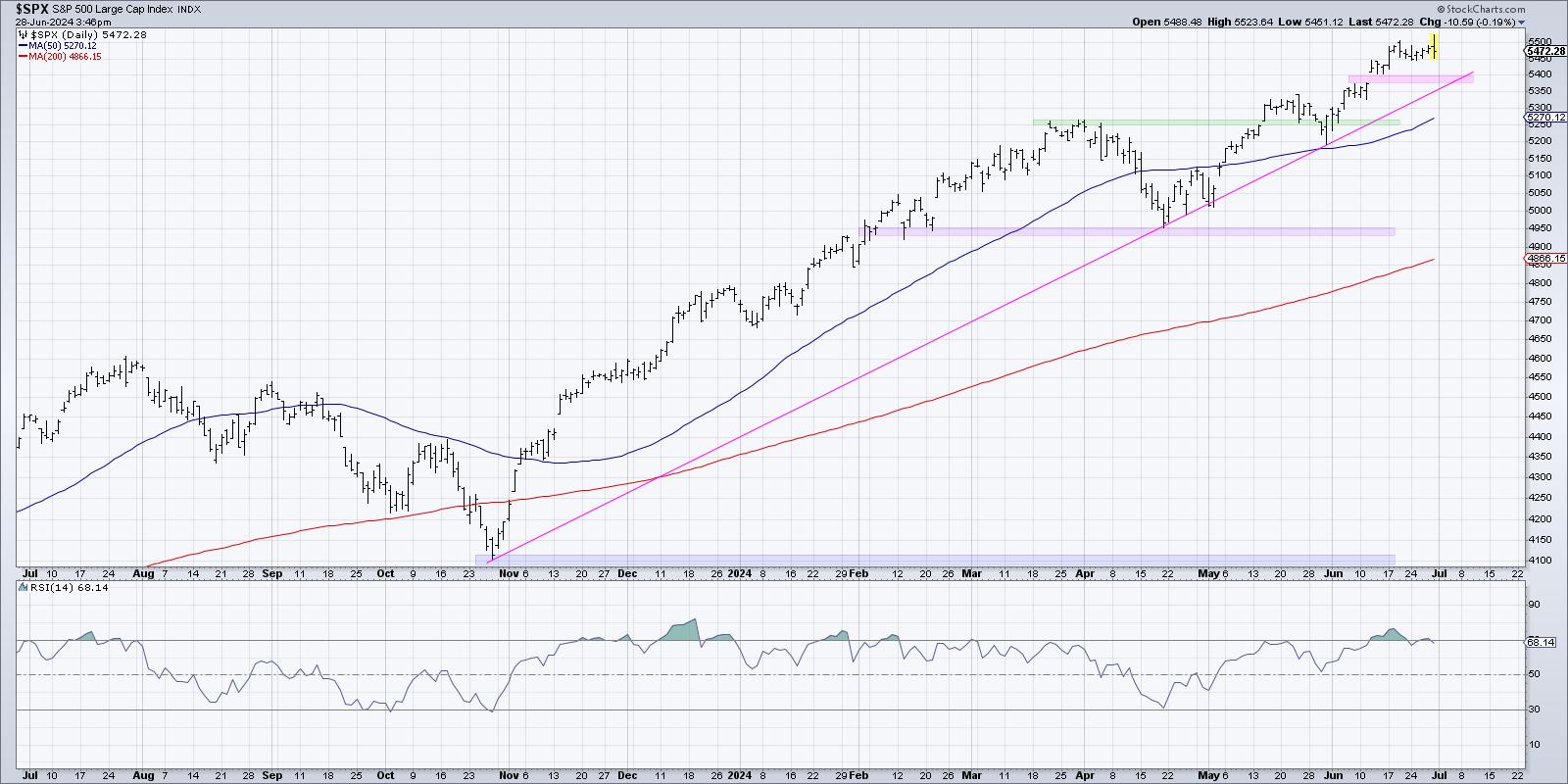
Friday's session, which initially showed a strong upside reaction after the release of the latest data for the Fed's favorite measure of inflation, ended up showing weakness as the S&P failed to close above the 5500 level. We remain constructive on the SPX as long as it remains above our "line in the sand" of 5400, which lines up well with trendline support using the major market lows back to October 2023.
I'm meeting up with my Market Misbehavior premium members on Tuesday, July 2nd, to conduct our virtual Monthly Chart Review of key charts to watch in Q3. I'd love for you to join us in this interactive discussion of market conditions! Find more info HERE and use code STOCKCHARTS at checkout for 20% off your first 12 months.
Looking a little closer at some of the top performers in 2024, we can see that some names have dramatically outperformed the SPX in the first half of the year. SMCI is up almost 200% year-to-date, Nvidia has gained around 150%, and the rest of the top ten are all over 50% compared to the S&P 500's +15% return.

A small number of these strong performers are still pounding out new highs. For example, Eli Lilly (LLY) closed above $900 for the first time this month, continuing a run of incredible strength off its April low. But the real story is that many of these top performers are actually well off their 2024 highs.
NVDA spent this week about 10-15% below its all-time high earlier in June, while Super Micro Computer is still about 30% below its peak above $1200 in March. So the "best of the best" performers are not necessarily screaming strength going into Q3.
So which charts should we be watching going into July, which has traditionally been a very strong month for the S&P 500?
I hereby present the three charts I'll be focused on, which I call the "MAG" stocks: Meta Platforms (META), Amazon.com (AMZN), and Alphabet (GOOGL). All three are at key technical moments, and all three have the opportunity to either confirm a new market uptrend or raise a red flag of caution. Let's break them down one by one.

The question for META is whether it can trade not just to resistance but through resistance. Meta Platforms first reached $125 in March, then retested that resistance level again in April and once again in June. When price reaches a key resistance level, it's all about whether an influx of willing buyers can push the price to new highs. This increase in buying power is what could propel META to new highs, which would certainly help the S&P 500 and Nasdaq achieve further highs.
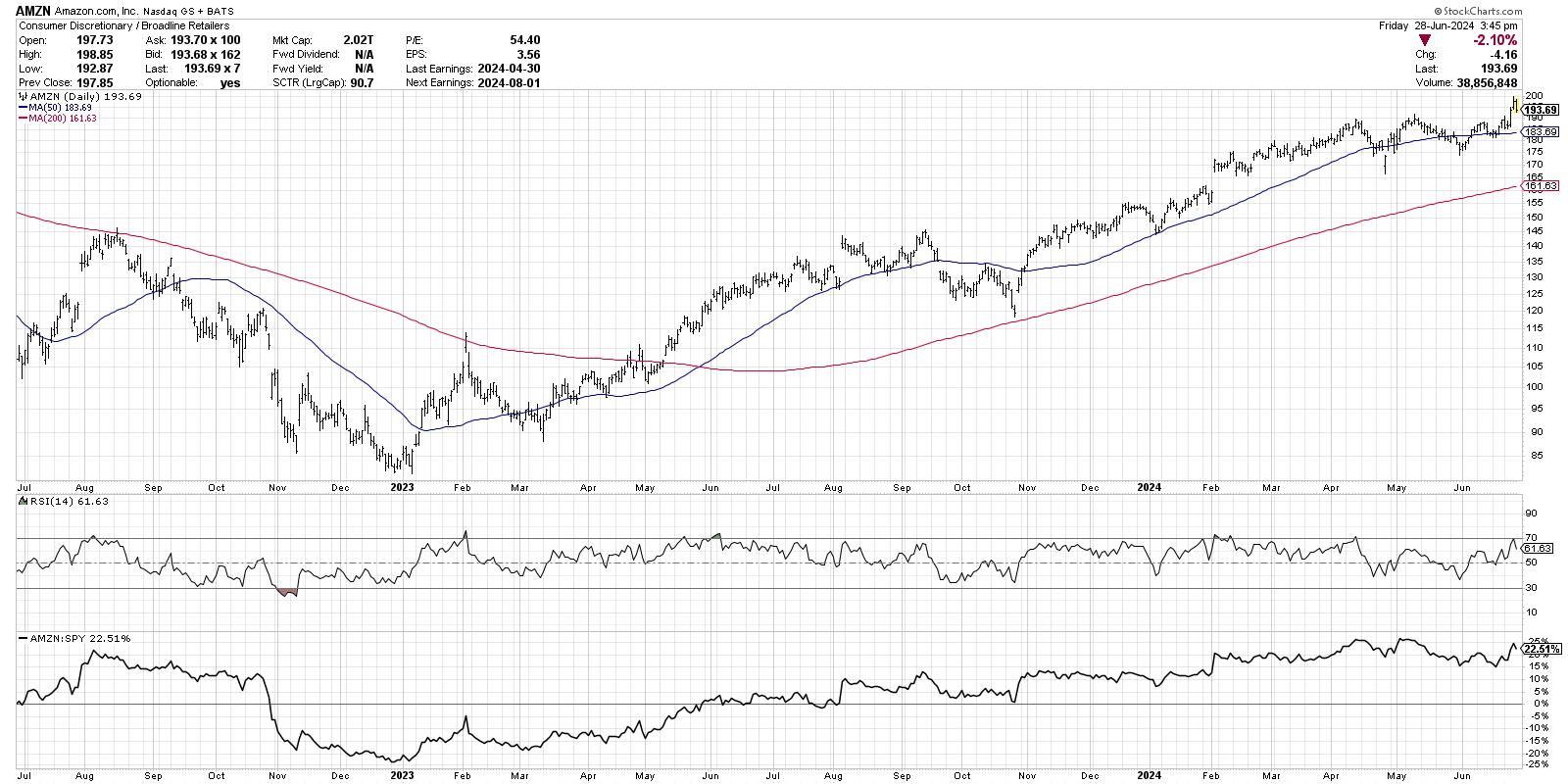
Amazon.com has already broken to new highs earlier in the week, but Friday's session saw this leading consumer name pullback toward the breakout level at $190. For a chart like AMZN, it's all about whether we can remain above the breakout level. Amazon over $190 is a strong chart with a recent breakout, but Amazon below $190 would represent a failed breakout and lack of upside follow-through.
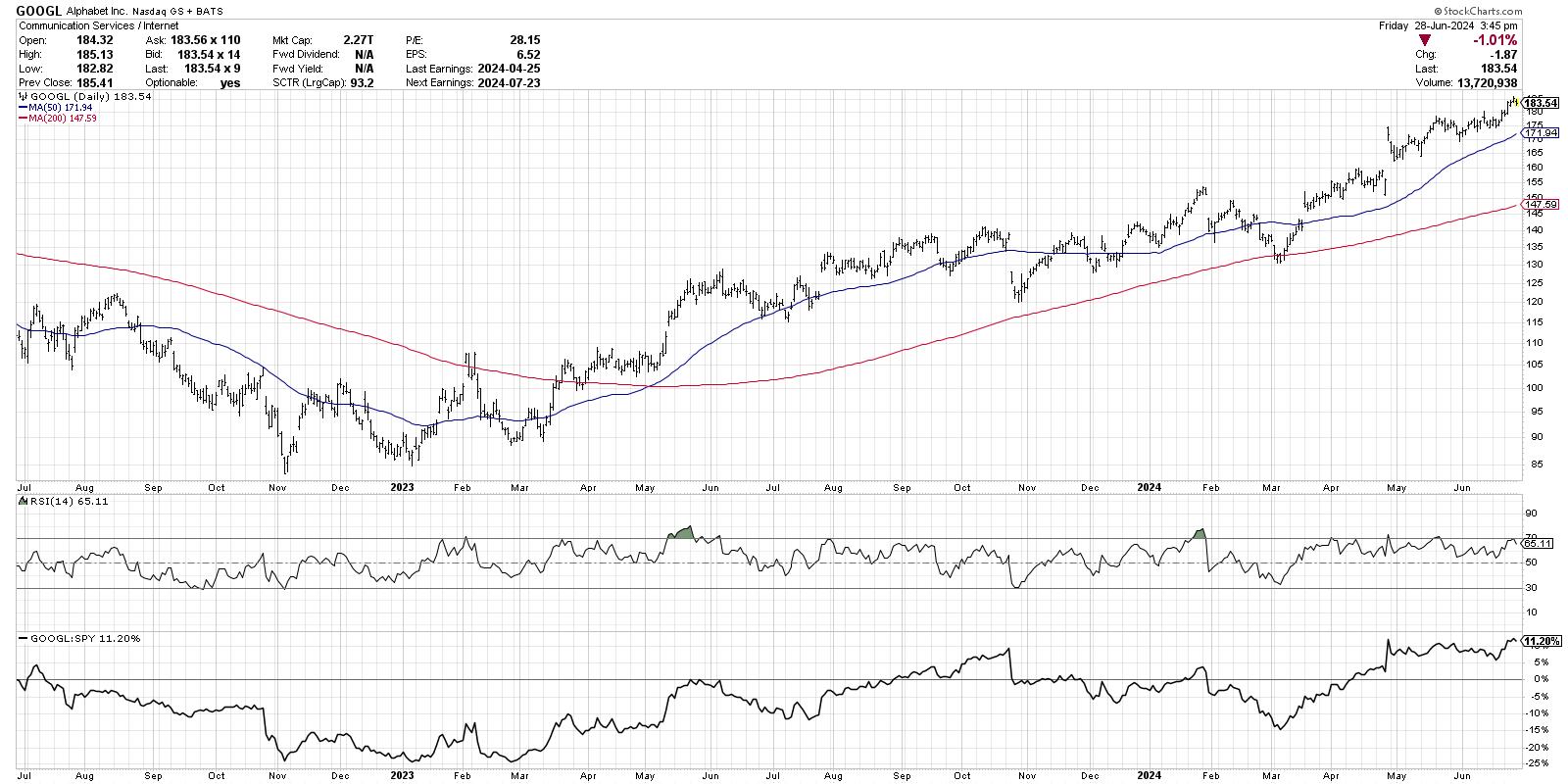
In Alphabet, we see a stock very clearly in a primary uptrend of higher highs and higher lows. Can GOOGL sustain the strong bull phase from Q2 into Q3? With this sort of technical configuration, I'm watching the pullbacks to see if GOOGL can keep making higher lows. My mentor Ralph Acampora would remind me to focus on higher lows in an uptrend, because, as long as the lows keep getting higher, the uptrend appears to be in good shape.
I'm also watching the RSI, which has been above 50 since mid-March. Strong charts have strong momentum, and RSI remaining above 50 would tell me that Alphabet is still in a position of strength among the largest US stocks.
So even though top performers like Nvidia have pulled back, our major equity benchmarks can certainly drive higher. But it will fall to charts like the MAG stocks to demonstrate that investors remain optimistic, and that the optimism is reflected in rising stock prices. Because as long as leading growth names keep leading, this market has plenty of upside potential.
RR#6,
Dave
P.S. Ready to upgrade your investment process? Check out my free behavioral investing course!
David Keller, CMT
Chief Market Strategist
StockCharts.com
Disclaimer: This blog is for educational purposes only and should not be construed as financial advice. The ideas and strategies should never be used without first assessing your own personal and financial situation, or without consulting a financial professional.
The author does not have a position in mentioned securities at the time of publication. Any opinions expressed herein are solely those of the author and do not in any way represent the views or opinions of any other person or entity.
|
| READ ONLINE → |
|
|
|
| Martin Pring's Market Roundup |
| MEMBERS ONLY |
| Dow Transports Are Set for a Short-Term Rally, But Will It Be Enough? |
| by Martin Pring |
|
The Transportation Sector has been one of the weaker brethren of late. That's important, as this market average forms part of the Dow Theory, which many observers believe is currently signaling a bear market...
|
| READ ONLINE → |
|
|
|
| ChartWatchers |
| Stock Market's Choppy Action Continues: Focus is on Jobs Report, Powell Speech |
| by Jayanthi Gopalakrishnan |
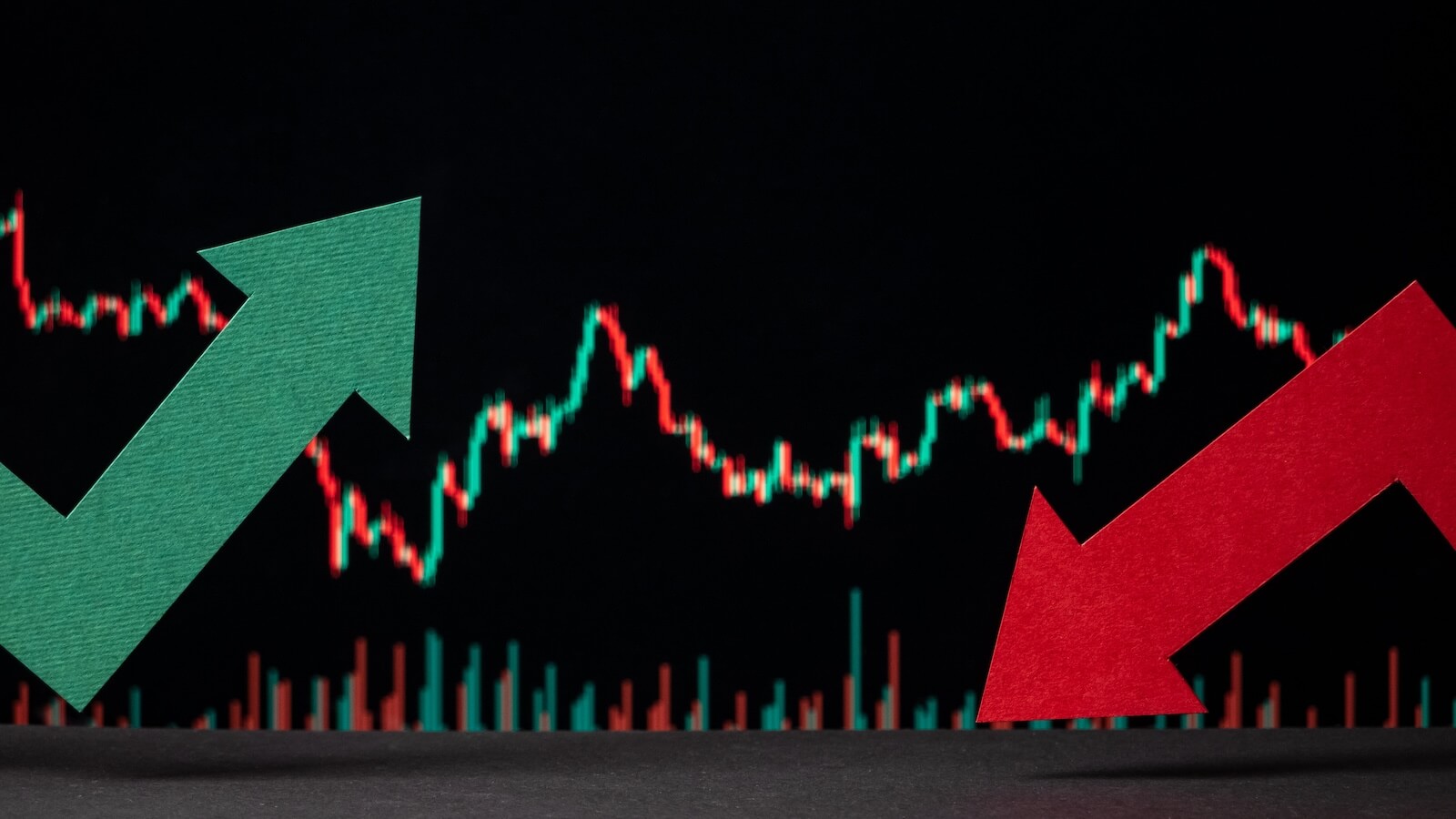
The stock market's theme this week seems to be indecision. This could continue until Chairman Powell speaks and the June payrolls number comes out next week. You'd think the May Personal Consumption Expenditures (PCE) report showing slowing inflation would boost equities, but while it technically did, it was brief.
Choppy Equities
If you look at a daily chart of the S&P 500 ($SPX), your first thought may be that the market didn't do much to end the trading week. But if you pull up an intraday chart, you'll see a lot of price movement. Initially, stocks rose, as did bond prices. But the rally was short; bonds quickly sold off, and equities stayed higher for over an hour before retreating. The S&P 500 ($SPX) touched a new record high, but the momentum quickly reversed. Equities remained flat for most of the trading day and sold off at the close.
This may be disappointing for bulls as the trading week, month, quarter, and first half of the year ends. But, overall, the year's first half has been a great ride for equities. Maybe investors are getting nervous about the second half of the year, which may be why the stock market is stalling.
The S&P 500 hasn't been doing much since last Thursday. It pulled back mainly due to NVIDIA's selloff, and then it slowly tried to make its way back up (see chart below). But selling pressure came in quickly when it moved too much higher and took the index back down.
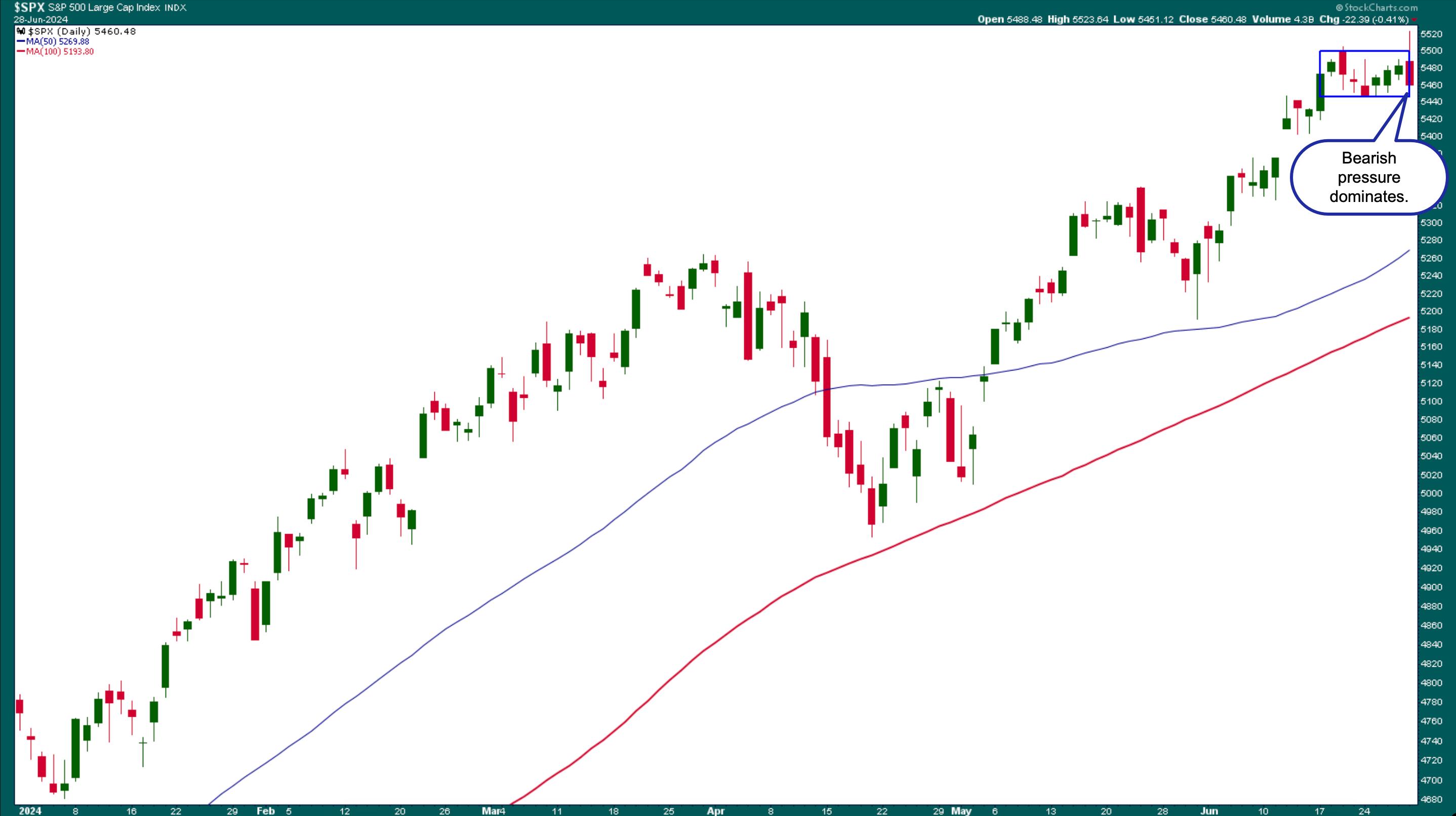
CHART 1. CHOPPY STOCK MARKET. The S&P 500 index has been moving sideways for over a week. Will next week present a different picture?Chart source: StockCharts.com. For educational purposes.
The S&P 500 has been moving within a relatively narrow range, and when it tried to break out of this range, it quickly returned. It feels as if bearish pressure quickly jumps in when things get a little too bullish.
Friday's price action suggests that the market may have hit an exhaustion level, given that the bullish pressure couldn't hold. The candlestick bar shows that bearish sentiment dominated the day's trading. The Nasdaq Composite ($COMPQ) shows similar price action.
If you pull up the weekly chart of the S&P 500 (see below), it's clear the week reflected indecision.
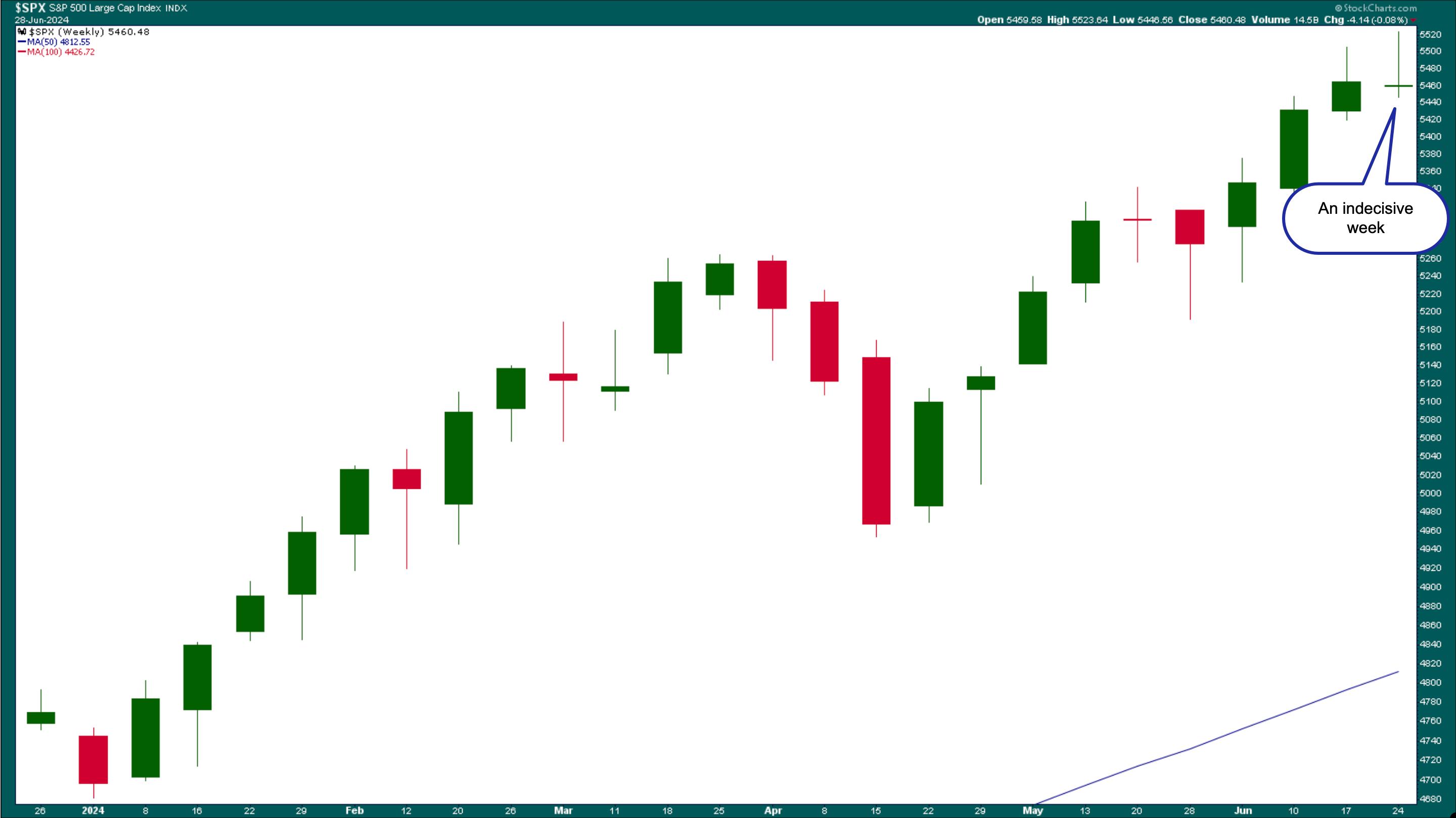
CHART 2. WEEKLY CHART OF S&P 500 INDEX. The week ends on a note of indecision.Chart source: StockCharts.com. For educational purposes.
Next week is a short trading week, but there are some key data points on deck. There's the June PMI and the June jobs report. More importantly, we'll hear from Fed Chair Jerome Powell. Will he say something that will make the stock market more decisive? We'll have to wait and see, but, hopefully, something more exciting happens next week.
It's All About Interest Rates
Investors continue to focus on interest rate cuts. When will that first rate cut happen? There's speculation it could be as early as September, but that's iffy given that we're in an election year. It could be after the election, taking it to the November meeting.
The Fed has suggested one rate cut this year, which is what the stock market has priced in. Yet, there's still uncertainty among investors. The 10-year Treasury yield ($TNX) closed higher despite a PCE that indicated inflation is slowly coming down. However, it isn't at levels to be concerned about.
The daily chart of $TNX below shows that the 10-year yield is hitting a resistance level of its February and March highs. It's also close to its 100-day simple moving average (SMA). It'll take a lot for it to break above this level.
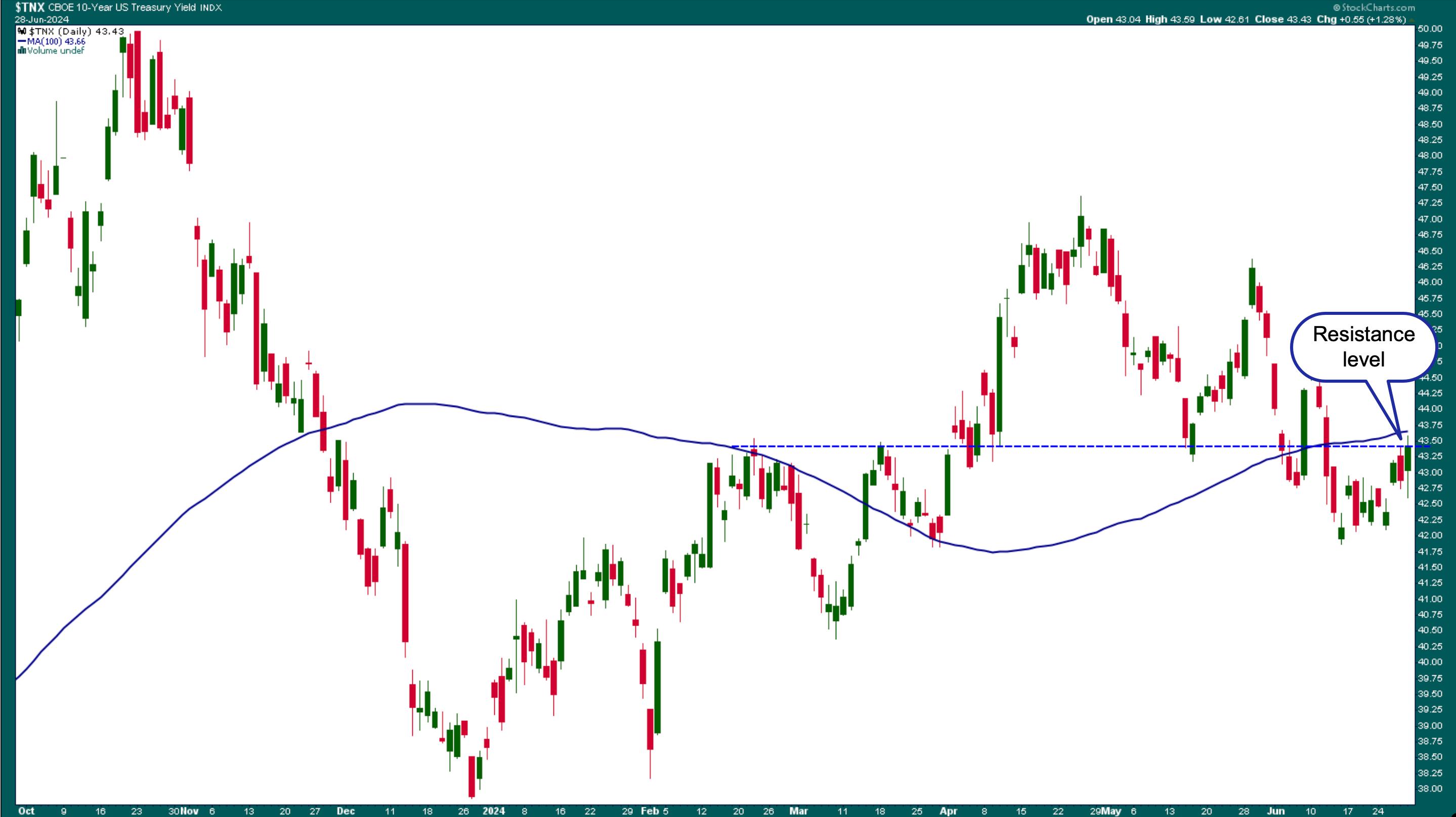
CHART 3. DAILY CHART OF 10-YEAR TREASURY YIELDS. While the 10-year yield rose, it's at a resistance level.Chart source: StockCharts.com. For educational purposes.
The Bottom Line
Despite this week's sideways move, the uptrend in the S&P 500 and Nasdaq Composite is still in play. Overall market volatility is still low, as reflected by the CBOE Volatility Index ($VIX). There's a chance we could get some decisiveness creep into the market next week, but don't be surprised if the choppiness continues. Next week could be slow. Happy Fourth of July!
End-of-Week Wrap-Up

- S&P 500 closed down 0.08% for the week, at 5460.48; Dow Jones Industrial Average down 0.08% for the week at 39,118.86; Nasdaq Composite closed up 0.24% for the week, down 0.23% at 17,732.60.
- $VIX down 5.76% for the week closing at 12.44
- Best performing sector for the week: Energy
- Worst performing sector for the week: Utilities
- Top 5 Large Cap SCTR stocks: NVIDIA (NVDA); Super Micro Computer, Inc. (SMCI); Vistra Energy (VST); Applovin Corp (APP); MicroStrategy Inc. (MSTR)
On the Radar Next Week
- June ISM Manufacturing PMI
- May JOLTs Report
- June US Jobs Report
- Fed Chair Powell Speech
- June FOMC Meeting Minutes
Disclaimer: This blog is for educational purposes only and should not be construed as financial advice. The ideas and strategies should never be used without first assessing your own personal and financial situation, or without consulting a financial professional.
|
| READ ONLINE → |
|
|
|
| The Traders Journal |
| 3 Essential Lessons We Investors Can Learn from Top Winemakers |
| by Gatis Roze |

"It takes 10 years to learn from the vineyard, and another 10 years to learn the wine from that vineyard." — James Molesworth
Metaphors and analogies are powerful teachers and offer behavioral adhesiveness. In other words, the ideas and lessons they present stick in our memory, and can thus more easily become part of our routines. Sports metaphors are everywhere, but I believe this analogy of investors and winemakers is also extremely powerful.
James Moleworth's perspective introductory quote is based on his career over three decades in the wine industry. Similarly, my own decades as a full-time investor yield a similar axiom. Not as frighteningly long term as his ten-and-ten perspective, but nevertheless, mine is perhaps closer to five-and-five.
If a winemaker can take two decades to hit a really consistent stride and produce top tier wines, investors who aspire to produce consistent out-performance and profits must also embrace a willingness to play the long game. Hence, keep in mind these three essential lessons:
 Investors should accept that their initial learning and growing phase will take years. Achieving mastery is worth the effort, but you don't get vaccinated with that ability in a one-day seminar. You must experience the seasons of the market and appreciate how you react to bullish, neutral, and bearish scenarios. During these years, you are blending disciplines, tinkering with your methodology, and beginning to demonstrate competence. Yes, you are mastering the vineyard. A vineyard of your investments. Investors should accept that their initial learning and growing phase will take years. Achieving mastery is worth the effort, but you don't get vaccinated with that ability in a one-day seminar. You must experience the seasons of the market and appreciate how you react to bullish, neutral, and bearish scenarios. During these years, you are blending disciplines, tinkering with your methodology, and beginning to demonstrate competence. Yes, you are mastering the vineyard. A vineyard of your investments.- Next, you move into the winemaker phase. You are harvesting what you learned. Like fine wine, successful investors can only be replicated with age. Of course, you need appropriate grapes to provide your foundation. But with each passing season in the markets, your wine (aka your skill set) will age and mellow, and you'll begin bottling out-performance and consistent profits. This is very akin to the passage of top-tier winemakers. If you aspire to consistent outperformance as an investor, you too must be willing to take a similar journey. I often paraphrase this quote: "I worked all those years to become an overnight success."As both an investor and connoisseur of fine wines, I want to assure you that both passages are worth the effort — truly!
- The third and final lesson is really the umbrella beneath which all this resides. The axiom is simple. Play the long game. Your portfolio will be healthier. Life will indeed be better.
"An investor who has all the answers doesn't even understand the questions. Success is a process of continually seeking answers to new questions" — Sir John Templeton
Sir Templeton certainly played an exquisite long game. Now, here's a bonus addendum that's totally separate from the three essential lessons above. Writing this blog has put me in a wine frame of wine! I've always maintained that wine journalists such as James Molesworth should teach college literature classes, because they are some of the best wordsmiths out there. These are a few hypothetical examples of how talented writers might describe bottles of vino:
- This wine is broad in feel but not lacking in cut.
- It's lushness doesn't sacrifice it's racy edge.
- It's bracing with hints of youthfulness buried there.
- Expressive waves harnessed in this elixir.
- A plump kiss inlaid seamlessly within the bottle.
- It's overt personae glistens with purity yet lurking beneath is a polished sophisticated racy element.
- It forms a tensile matrix steep in feel yet laced with bravado.
- It's taut and coiled with much energy in reserve.
- The vibrant bristling core that hasn't unwound yet.
- It sings beguiling notes expressing a hedonistic overall manner.
|
| READ ONLINE → |
|
|
|
| Trading Places with Tom Bowley |
| TAG, You're It! Rotation Away From Semiconductors Benefiting These Stocks |
| by Tom Bowley |
One hallmark of secular bull markets is rotation. When leading stocks, sectors, and industry groups falter, there needs to be others that grab the baton and help to keep the bull market intact. Semiconductors ($DJUSSC) have been the clear leader in the stock market for years, but especially since the end of October 2023, when the group embarked on its most powerful rally of the 21st century. Below is a 25-year chart of the DJUSSC. Pay particular note to the bottom panel, which reflects a 170-day rate of change (ROC), or roughly 8 months. Compare this most recent 8-month rally to other 8-month periods throughout this century:
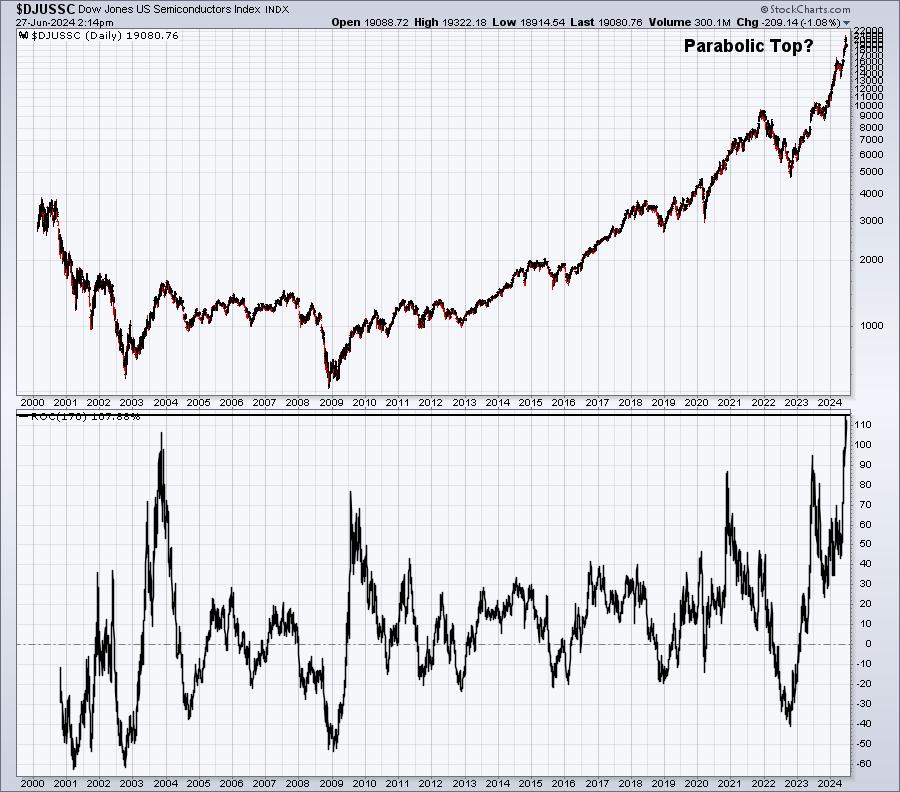
The 8-month ROC recently hit 115%, which is the biggest rally EVER on this index. And if you look at the price chart, we should at least CONSIDER the possibility that this is a parabolic top. This is how these form - with tremendous amounts of positivity and what could end up being unsustainable revenue and EPS growth. The entire group is being priced off of record revenue and earnings growth and for perfection. Should traders even get a HINT that future growth might be lower than what we've been experiencing the past couple quarters, the semiconductor trade could be weak for months, possibly quarters.
In a secular bull market, however, it's rotation that keeps our major indices in uptrends. Where might the new leadership emerge from if semiconductors do in fact weaken? Well, I think it's already showing here:
XLC:
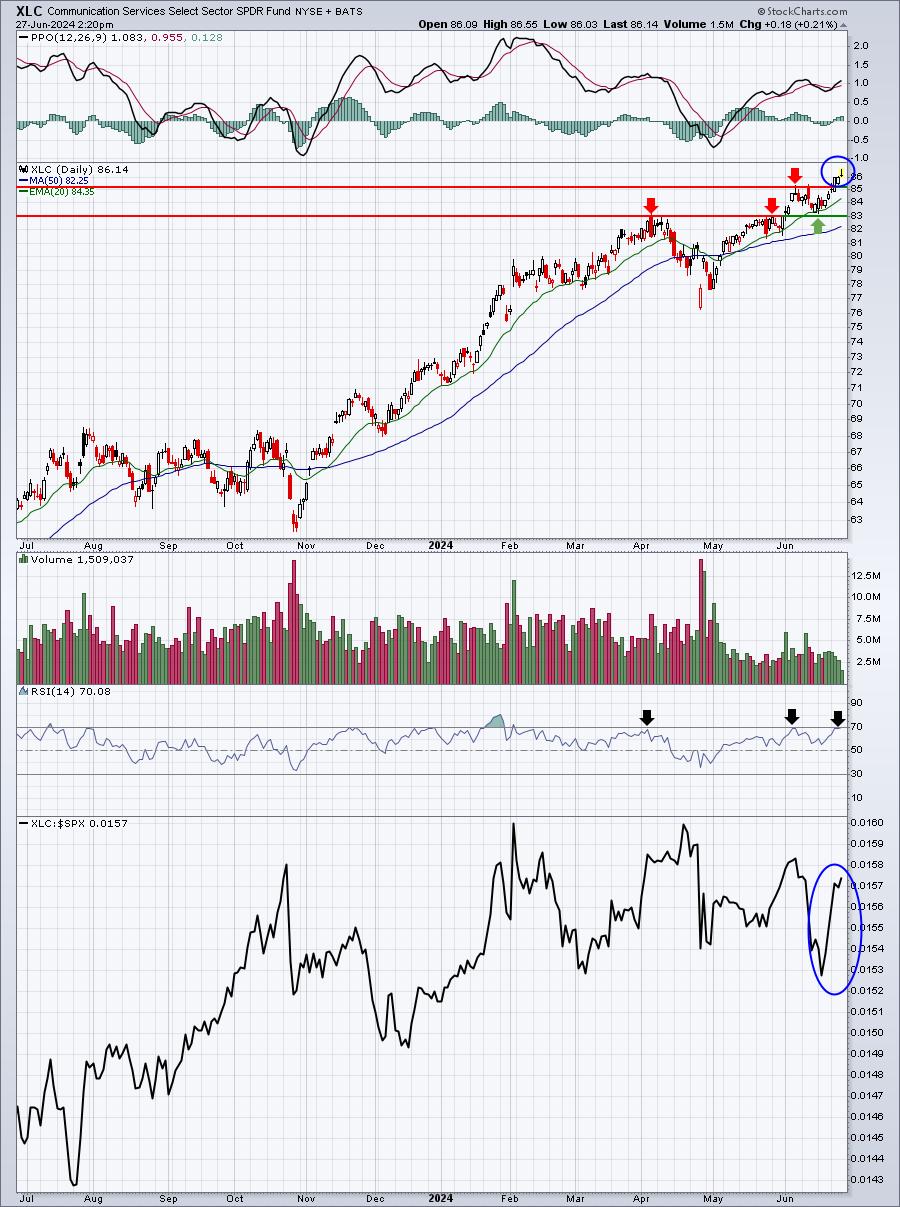
A breakout has already been made here. Yes, we're a bit overbought, but nothing like how overbought technology (XLK) has been. One industry that typically revs up when the XLC is hot is internet ($DJUSNS). This group remains in the midst a major rally:
$DJUSNS:
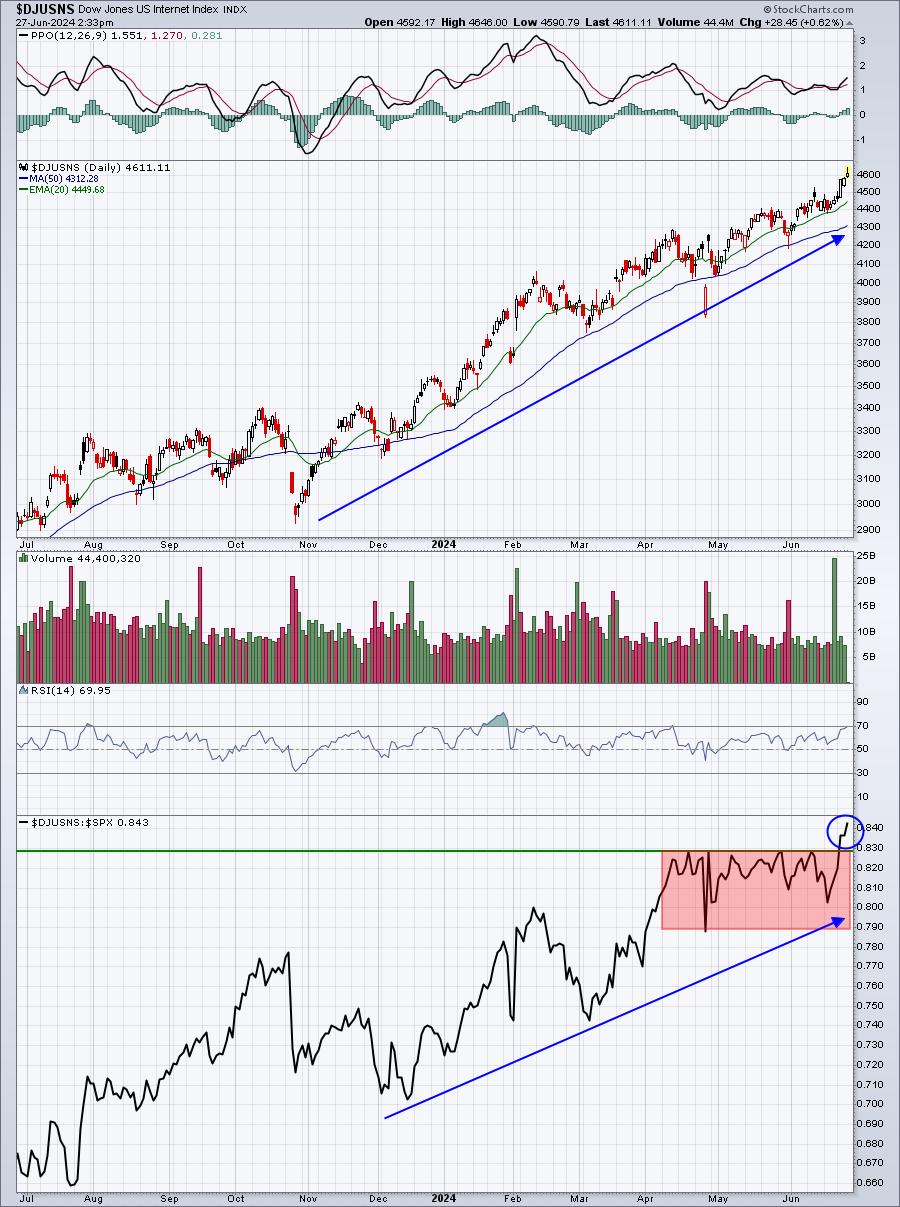
The red-shaded area highlights the fact that, on relative basis, internet hasn't been leading the past couple months. The breakout this week, though, might indicate renewed relative strength. It's also noteworthy that since the financial-crisis low in 2009, internet stocks have been leaders during July, rising in 14 of the past 15 years:
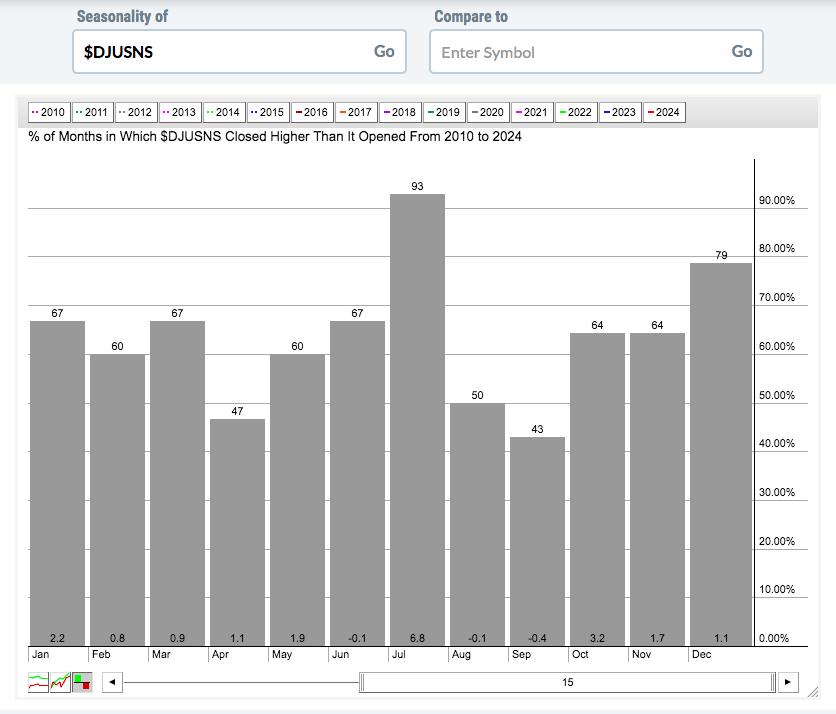
The average July return has been 6.8%, more than double any other calendar month since 2009.
There's one other key sector, consumer discretionary (XLY), that could play a big leadership role over the second half of 2024. This group has been a drag on U.S. equities, but it really hasn't been felt that much, because the XLK has been so strong. NOW is the time, however, when U.S. equities could be looking for rotation to and leadership from this sector:
XLY:
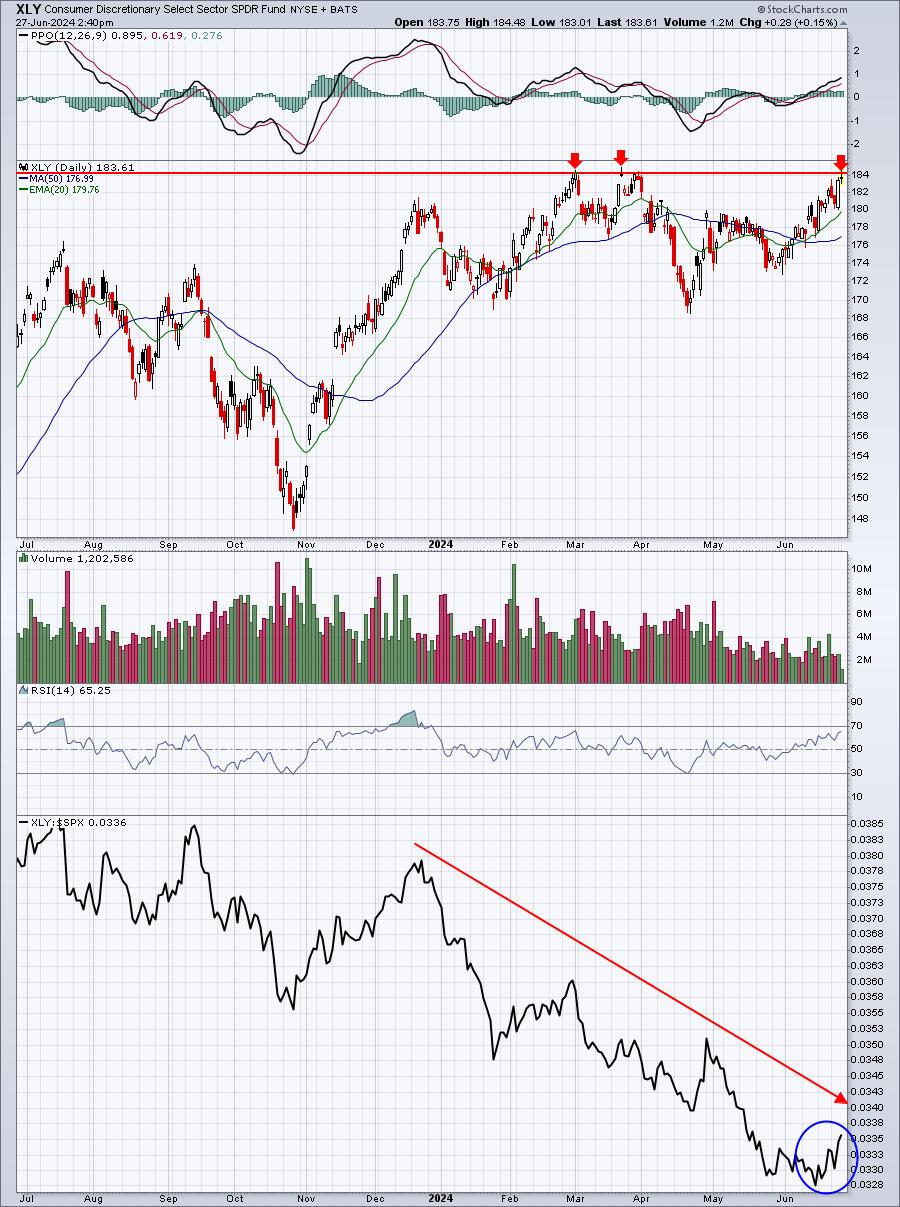
Relative strength has begun to turn higher over the past two weeks and this relative strength could be fueled much further by an absolute breakout in the price of the XLY near the 184-185 level.
It's been amazing what a stock like NVIDIA Corp (NVDA) has done for semiconductors, technology, and our major indices. But if NVDA struggles on a relative basis, which it certainly deserves, I see 3 critical stocks not named Apple (AAPL) and Microsoft (MSFT) that could swoop in and "save the day" for our major indices, especially the NASDAQ 100.
TAG, You're It!
Ok, so if we're going to need a replacement, temporary or otherwise, for a leadership stock like NVDA, which stock(s) might we look to for future leadership?
GOOGL:
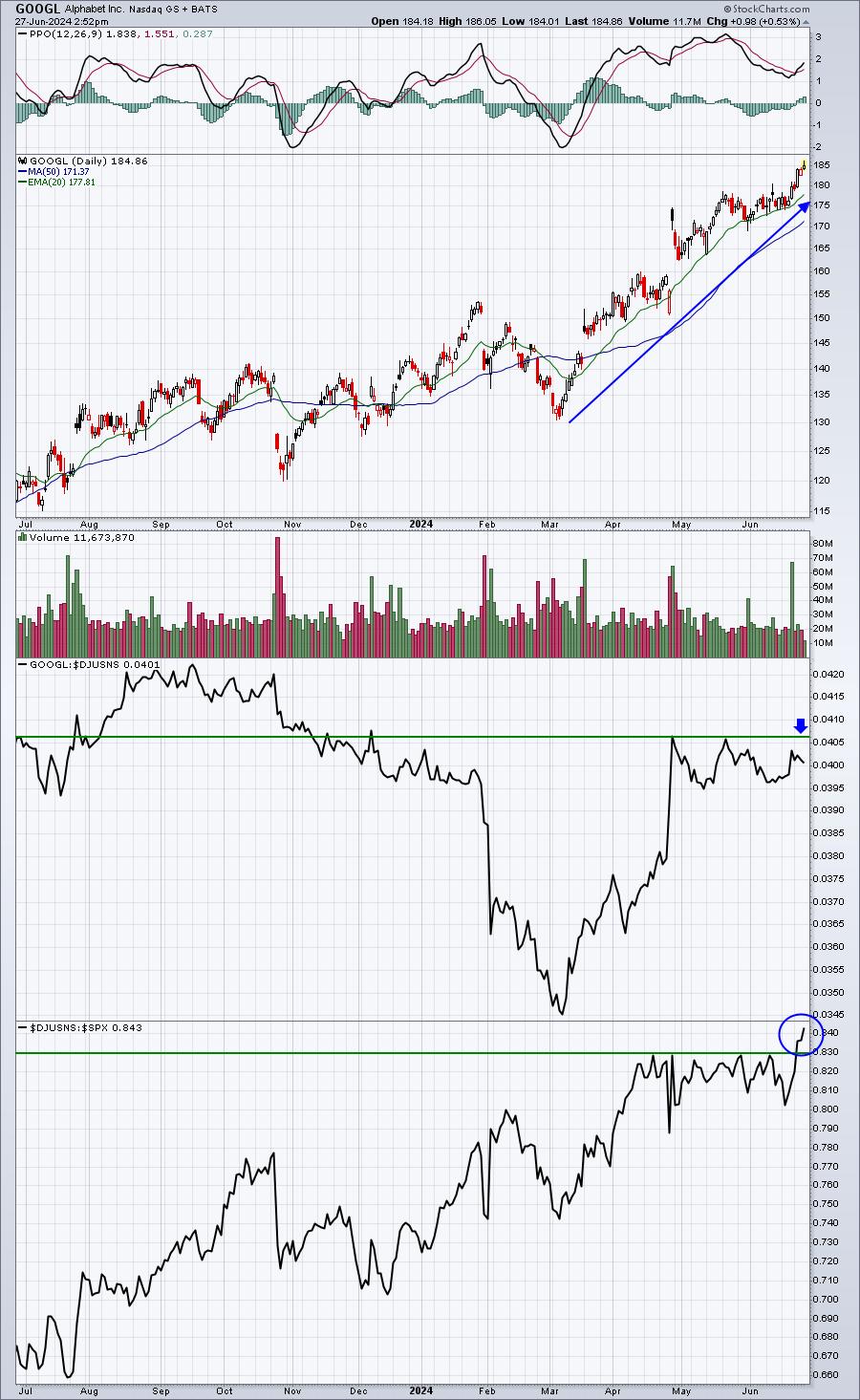
Relative to its peers, GOOGL hit rock bottom in early March. Since then, GOOGL has been significantly outperforming its internet peers and is currently awaiting another one. From mid-May to mid-June, GOOGL didn't go anywhere. Semiconductors were flying, but GOOGL took a back seat. Now that it's latest breakout to all-time highs have occurred, it certainly appears as though GOOGL is well-prepared to take the baton for the next leg of this secular bull market.
AMZN:
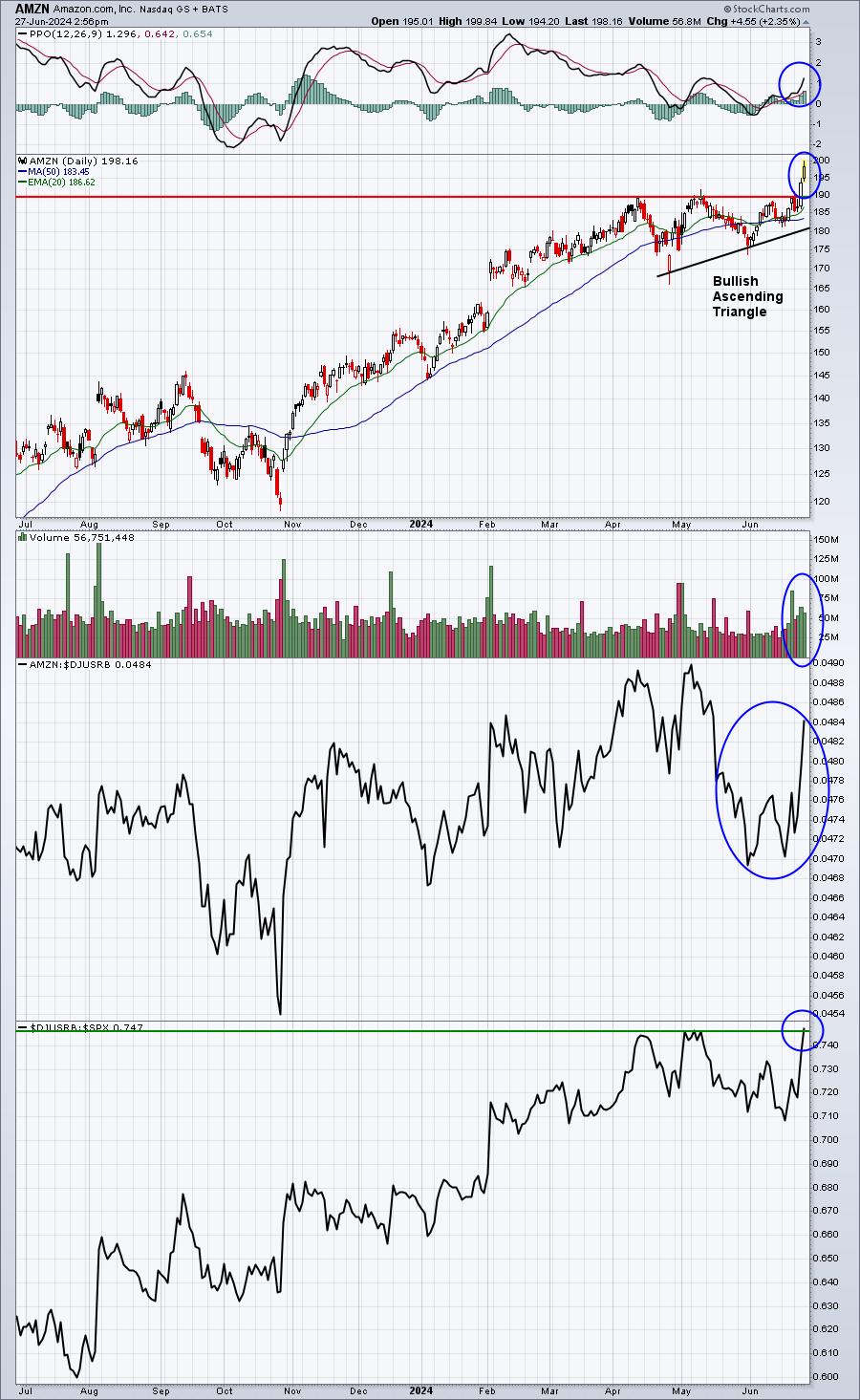
I don't know if there's a better stock anywhere right now. AMZN is absolutely one of my favorites. Discretionary stocks have been lagging most of the year and AMZN is the top holding in the XLY. AMZN just broke out, after consolidating, on excellent volume and I expect the stock to be a leader during the 2nd half of 2024. AMZN's best calendar month during this secular bull market (since 2013) has been July - check it out:
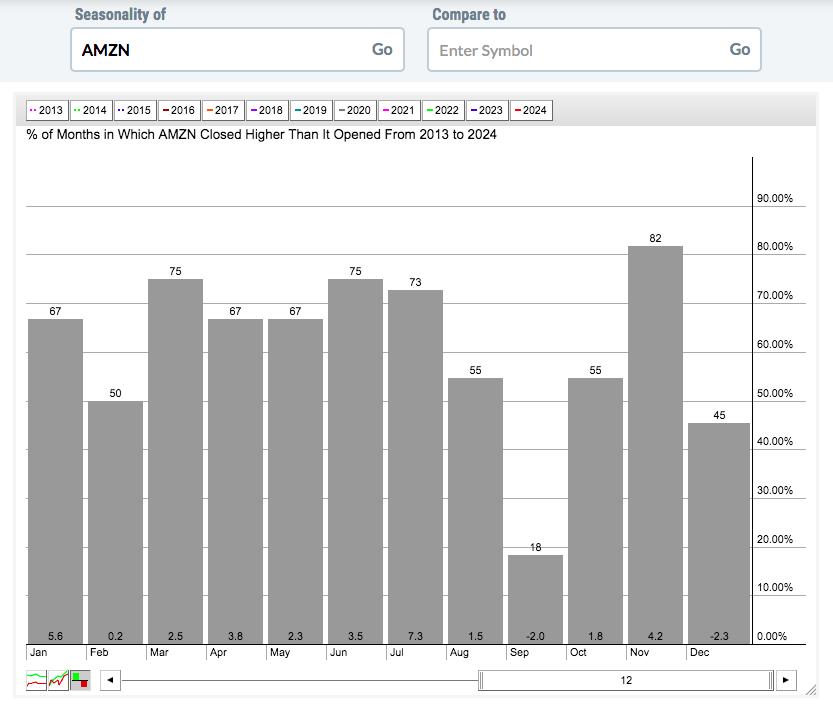
AMZN has climbed more often in November, but its actual average monthly performance in July (+7.3%) easily surpasses all other months. So we have technical conditions turning bullish just as we move into, arguably, AMZN's best month.
TSLA:
Ok, I get it. TSLA's been disappointing for sure. But there are improvements on the chart that suggest TSLA could be on the verge of a much bigger run. We do need to see one more key price level cleared to give me more confidence of a big rally:
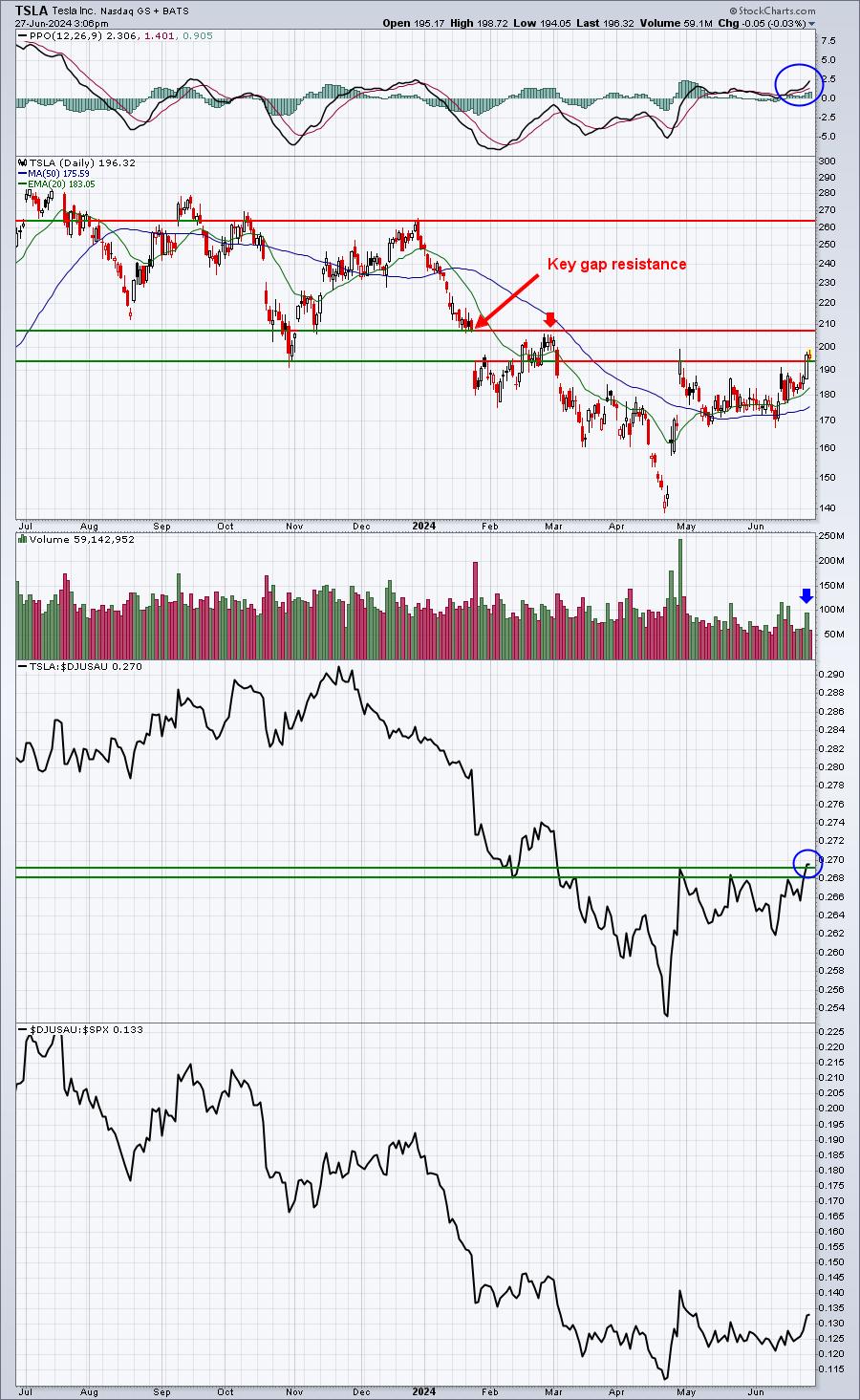
I see rather significant improvement in momentum (PPO), volume trends, and relative strength. TSLA, relative to its auto peers, just hit nearly a 4-month high. This, combined with other technical improvements, tells me that we could just be getting started here. I do want to see gap resistance near 208 cleared, because after that, I don't see any major resistance until 265 or so.
There's one more thing to like. Over the past 6 years, June, July, and August have posted AMAZING average returns. This time of the year is when TSLA has really shown extreme absolute and relative strength. Check out this seasonality chart:
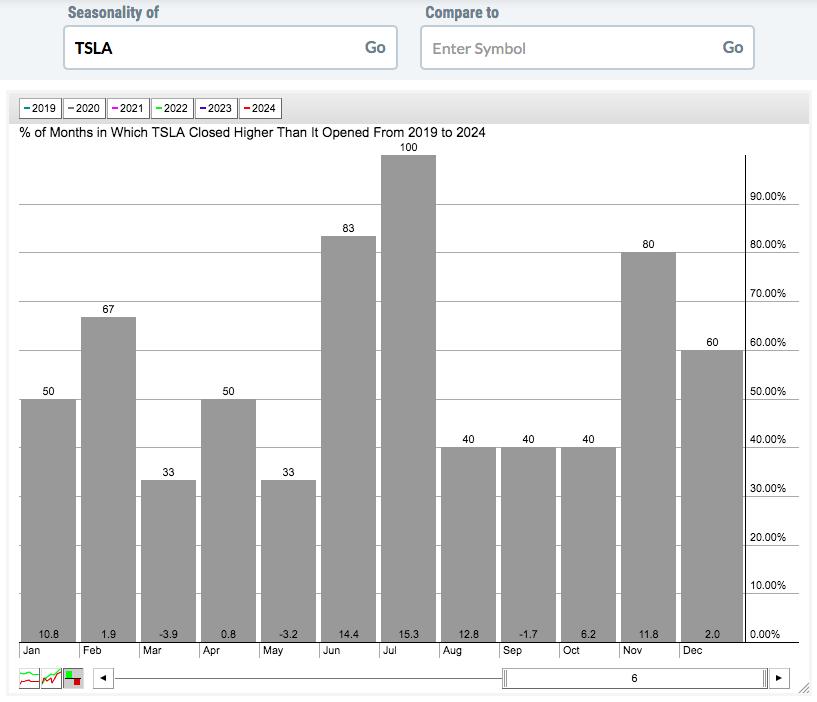
The average return during June, July, and August has been a STAGGERING and BLISTERING 43%!!! That's the AVERAGE since 2019. So if TSLA is going to get the job done, history tells us that NOW is the time.
Remember, the sustainability of secular bull markets is not much different than the game we all played as kids. Hey AMZN, GOOGL, and TSLA! You're IT!!!!
I published my first StockCharts YouTube video in quite awhile and it's great to be back! I spent a lot of time discussing the beauty of secular bull markets and how rotation keeps them alive, providing areas to keep a close eye on for future leadership. Please be sure to check out the video HERE and also be sure to hit that "Like" button and "Subscribe" to the StockCharts YouTube channel! I'd really appreciate the support!
Happy trading!
Tom
|
| READ ONLINE → |
|
|
|
| Wyckoff Power Charting |
| End of Quarter NASDAQ 100 Pile-On |
| by Bruce Fraser |
 The NASDAQ 100 ($NDX) has been surging higher since October 2023 with the pace of advance accelerating in the second quarter of 2024. These 100 components are among the largest market capitalization NASDAQ Composite ($COMPQ) stocks. All of the ‘Magnificent-7' mega-caps are represented in this index. Now the second quarter is concluding and the $NDX has been leaping upward in what Wyckoffians would describe as a climactic pace. End-of-Quarter window dressing is suspected. Institutional types are deploying available cash into hot-hot Mag-7 stocks prior to Quarter-End. NVDA alone has added about 1 trillion dollars of market cap to its valuation in about a month .... Stunning. Only institutions, en masse, have the buying power to propel valuations higher in such a brief period of time. And this stampede of buying has been rushed into the end of a three-quarter uptrend. Such Buying Climaxes are often reversed suddenly and sharply in what Wyckoff terms an Automatic Reaction (AR). We will watch for the possibility of such a reversal in the third quarter. If institutions are accelerating their buying into the current calendar quarter, then demand should dry up as the month and quarter rolls over. The NASDAQ 100 ($NDX) has been surging higher since October 2023 with the pace of advance accelerating in the second quarter of 2024. These 100 components are among the largest market capitalization NASDAQ Composite ($COMPQ) stocks. All of the ‘Magnificent-7' mega-caps are represented in this index. Now the second quarter is concluding and the $NDX has been leaping upward in what Wyckoffians would describe as a climactic pace. End-of-Quarter window dressing is suspected. Institutional types are deploying available cash into hot-hot Mag-7 stocks prior to Quarter-End. NVDA alone has added about 1 trillion dollars of market cap to its valuation in about a month .... Stunning. Only institutions, en masse, have the buying power to propel valuations higher in such a brief period of time. And this stampede of buying has been rushed into the end of a three-quarter uptrend. Such Buying Climaxes are often reversed suddenly and sharply in what Wyckoff terms an Automatic Reaction (AR). We will watch for the possibility of such a reversal in the third quarter. If institutions are accelerating their buying into the current calendar quarter, then demand should dry up as the month and quarter rolls over.
The chart study below illustrates early signs of exhaustion among the elite growth stocks of the NASDAQ 100. The study is of the $NDX advance / decline line as a representation of the breadth of participation of these 100 stocks. Note that with the late March price high in the index (first quarter window dressing) the A/D line peaked. It has not exceeded this level in the three months since. With the torrid rise of the $NDX in the second quarter, a clear and dramatic divergence has developed. Breadth divergences often warn of an impending ‘Change of Behavior' in the stock market indexes.
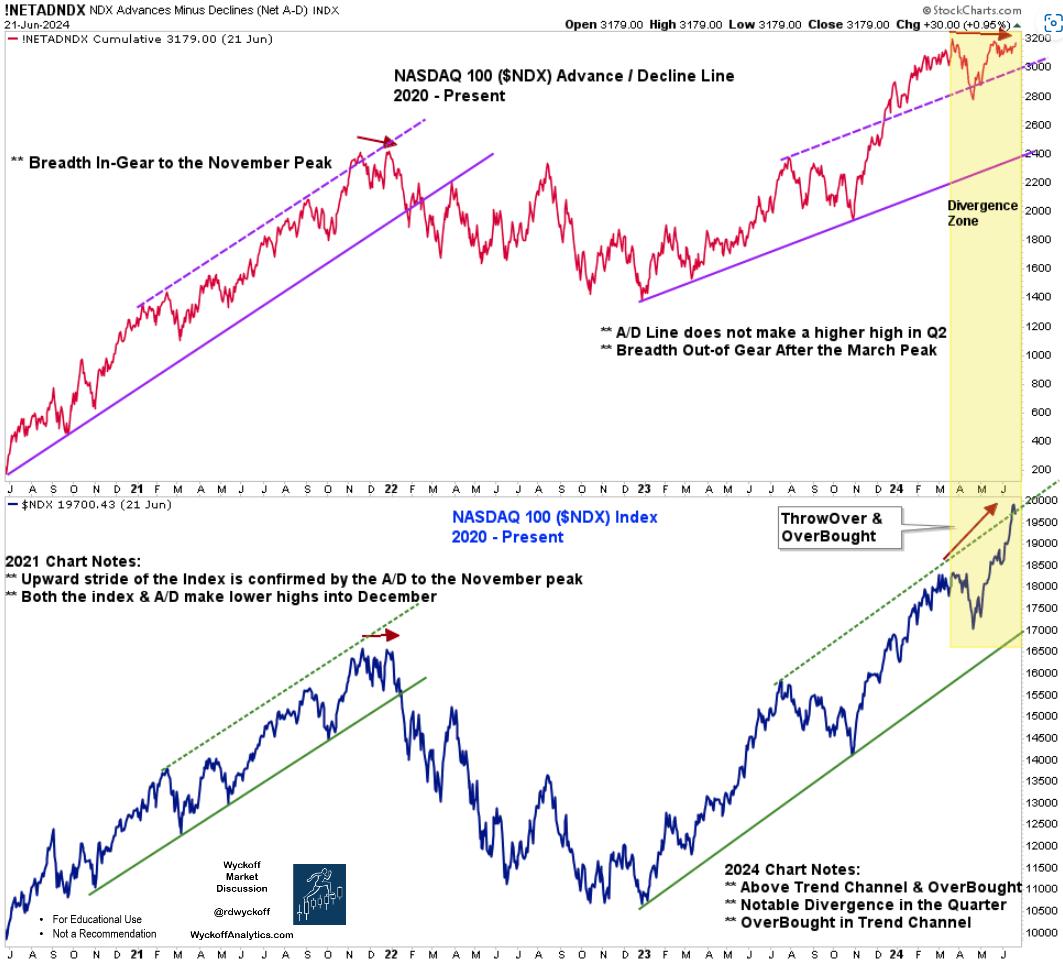
NASDAQ 100 Index with Advance / Decline Line 2020-2024
Chart Notes:
- During 2021 the $NDX and the A/D line climbed lockstep to the Bull Market peak in November.
- In March 2024 the NASDAQ 100 A/D Line peaked and, so far, has not matched that peak in the second quarter. The $NDX has soared to new heights since then, creating a dramatic divergence.
- During the second quarter NVDA climbed above the 3-Trillion dollar mark becoming the largest market capitalization company exceeding both AAPL and MSFT. During the year NVDA has added nearly $2T to its market capitalization (through June 19th). Much of the strength of the $NDX in the quarter is attributable solely to NVDA.
- The NASDAQ 100 index is composed of the premier growth stocks of this bull market. The A/D Line of the index indicates the majority of these elite growth names have paused in their respective uptrends. This A/D Line divergence confirms the narrowing of money flows into fewer elite growth stocks.
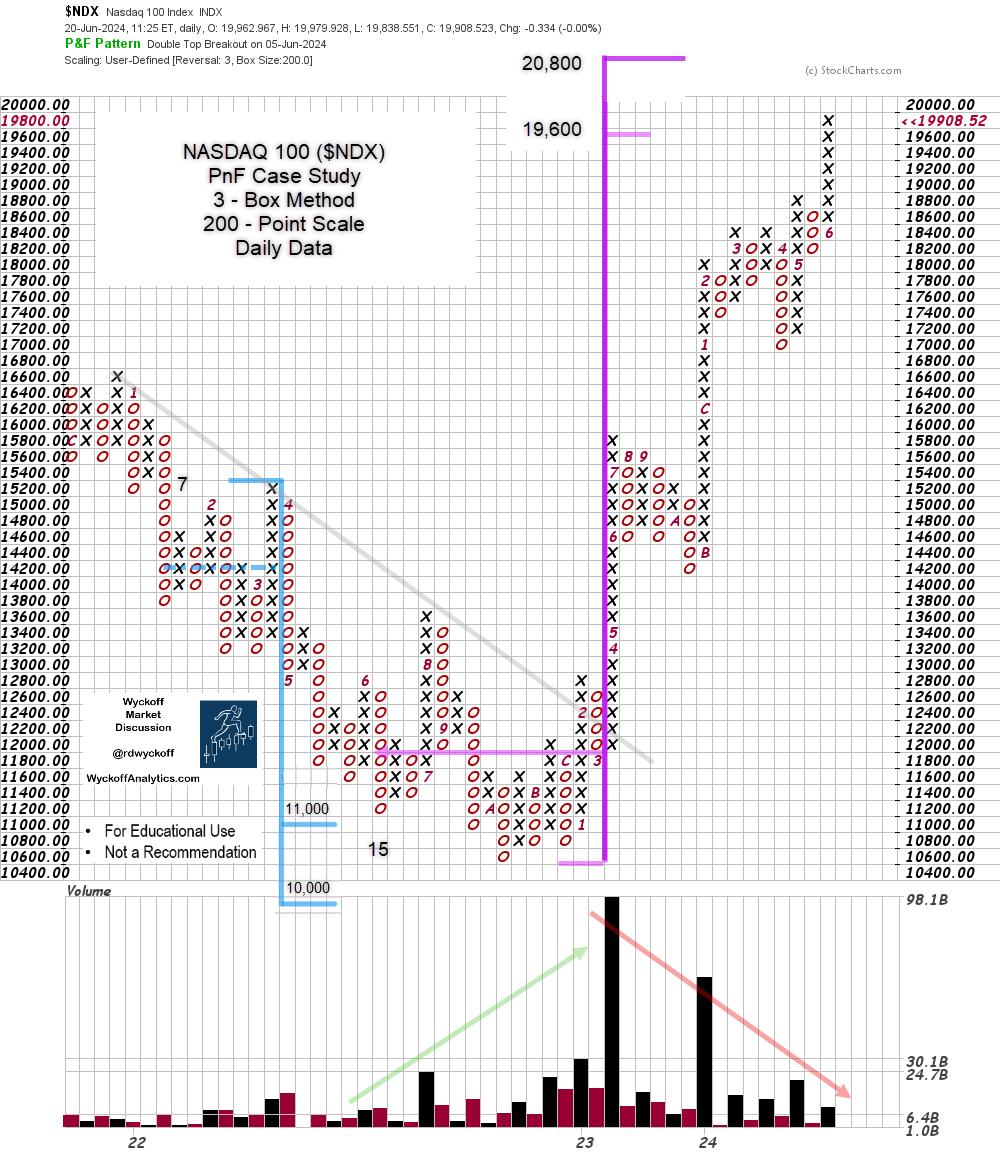
NASDAQ 100 Index Point & Figure Case Study
While the NASDAQ 100 A/D Line was making an internal momentum peak at the end of the first quarter the Point & Figure price targets estimated by the 2022-23 Accumulation still had higher to go. On this PnF chart March concluded with an entry at 18,000. The estimated price target of the Accumulation in this study is 19,600 / 20,800. NVDA and other stocks in the $NDX accommodated and continued climbing in the second quarter to the PnF price targets, reaching 19,800 in late June.
Chart Notes:
- A sudden and sharp reaction would suggest the start of a range-bound condition. This has not happened yet. The uptrend may have further to climb. A period of Cause Building would be expected to follow. Only then could it be determined if Re-Accumulation or Distribution is underway.
- Note the diminishing volume with each upward thrust of the trend. Demand is waning. Another warning that fewer stocks are propelling the index to new heights.
- Study how the Re-Distribution count of early 2022 flagged the Selling Climax low and the cause building process of Accumulation that resulted.
The PnF study above pointed to higher price objectives as the momentum peaked in March and a few Mega-Cap stocks accommodated during the next quarter. Now the $NDX is in the process of fulfilling those higher price objectives. Wyckoffians have a checklist of what to watch for when determining the intentions of the large Composite Operators as the last half of the year approaches.
All the Best,
Bruce
@rdwyckoff
Disclaimer: This blog is for educational purposes only and should not be construed as financial advice. The ideas and strategies should never be used without first assessing your own personal and financial situation, or without consulting a financial professional.
Helpful WPC Blog Links:
Trifecta of Trouble (Click Here)
Distribution Definitions (Click Here)
Wyckoff Power Charting. Let's Review (Click Here)
Wyckoff Resources:
Additional Wyckoff Resources (Click Here)
Wyckoff Market Discussion (Click Here)
|
| READ ONLINE → |
|
|
|
| Don't Ignore This Chart! |
| Can Nvidia's Stock Skyrocket Again? Key Levels to Watch Now! |
| by Karl Montevirgen |

Waiting for a perfect setup—technically or fundamentally—can sometimes be a perfect way to miss an opportunity. The disruptor is market sentiment, as it jumps the gun on an opportunity hoping to be validated well after pulling the trigger.
Case in point: NVIDIA (NVDA) in March 2023. The article NVDA Stock: Waiting For a Big Plunge? warned against buying into strength, as technical indicators signaled a potential pullback while also warning that the depth of a pullback is always unpredictable.
Instead of pulling back to $230 (or $23 after its recent 10-for-1 split), it pulled back to $250 ($25) before market sentiment, again the disruptor, snatched the opportunity that later would be validated by fundamentals.
Viewing a weekly chart, here's what happened. Take a look at the blue arrow. That was the week of the "dip."

CHART 1. WEEKLY CHART OF NVDA. See the blue arrow? That was the buy signal last time around.Chart source: StockCharts.com. For educational purposes.
You have to squint to see the blue arrow, which seemed like a significant decision point for bulls and bears at the time. But as investor sentiment wagered on the upside, AI demand clarified that a new "era" of artificial intelligence far outweighs a short-term market opportunity. And so you see what happened.
Is NVDA a Buy Now, or Is the AI Trade Over?
NVDA share prices have fallen hard following the euphoria driven largely by the stock split. Wall Street analysts see limited upside for Nvidia in the near term and have been known to revise their targets.
In the long term, NVDA's outlook remains positive, due to the growing importance of AI and NVDA's dominant position in the AI hardware market. So, while short-term gains may be modest, the chipmaker is expected to outperform the market in the long run.
But corrections can turn into downtrends. So, if you are bullish on NVDA, here are the levels to watch. Take a look at NVDA's daily chart below.

CHART 2. DAILY CHART OF NVDA. NVDA shares are falling. But will the decline remain a dip, or might it cascade into a much stronger downtrend?Chart source: StockCharts.com. For educational purposes.
While the Chaikin Money Flow (CMF) indicates that buying pressure remains positive, it also shows bullish momentum in a steep decline. The Money Flow Index (MFI), a volume-weighted RSI, confirms this reading, showing prices declining from overbought levels alongside a bearish divergence between the indicator and NVDA.
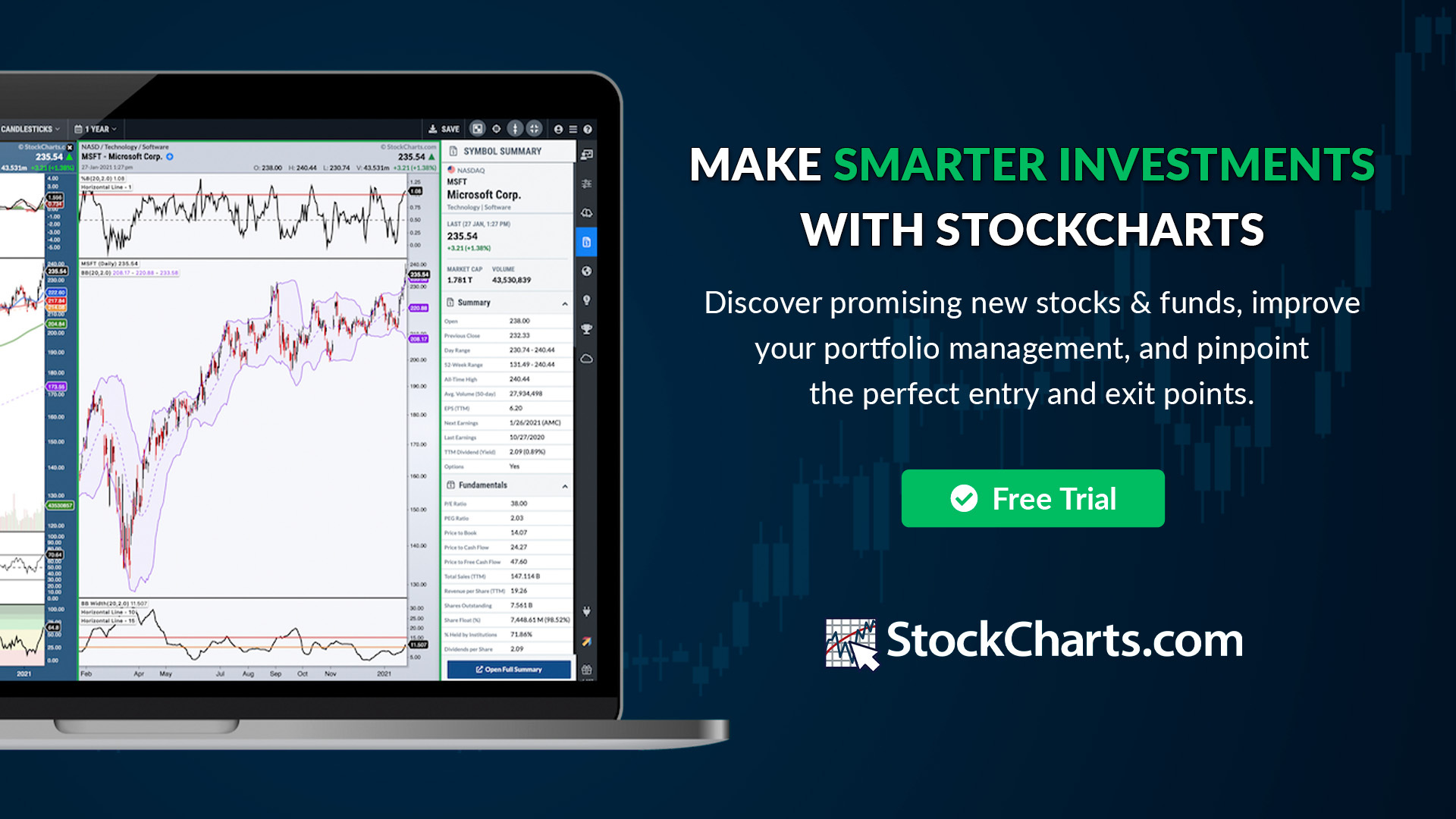
The chart plots an Ichimoku Cloud (kumo) to map out a wider context to anticipate potential support. Here's what to keep an eye on:
- The cloud coincides with the 50% and 61.8% Fibonacci Retracement levels, which generally serve as favorable buying levels if you want to go long.
- The 50-day simple moving average (SMA), also commonly viewed as a potential support level, is also looking to converge with the 50% Fib level.
- The 50% and 61.8% Fib levels, along with the top and bottom end of the cloud, also match the two Runaway Gaps, which, if filled, tend to serve as support levels.
In short, the actionable buying range sits between $105-ish and $110. Of course, ultra-bullish market sentiment can disrupt this setup (as it did in March 2023) and send NVDA prices higher and sooner.
On the bearish side, if NVDA falls below $100, there's a possibility the correction will become an intermediate-term downtrend. What can trigger this scenario? Unimpressive earnings in the next few quarters (its next earnings is in August).
The Takeaway
While NVDA's long-term outlook remains bright thanks to its stronghold in the AI hardware market, expect near-term weakness. The key levels to watch for potential support are around $105 to $110, with ultra-bullish sentiment potentially pushing prices up sooner. However, if NVDA drops below $100, we could see a longer downtrend, especially if upcoming earnings disappoint. So, keep an eye on those levels and market sentiment to time your moves wisely.
Disclaimer: This blog is for educational purposes only and should not be construed as financial advice. The ideas and strategies should never be used without first assessing your own personal and financial situation, or without consulting a financial professional.
|
| READ ONLINE → |
|
|
|
| MORE ARTICLES → |
|













 Investors should accept that their initial learning and growing phase will take years. Achieving mastery is worth the effort, but you don't get vaccinated with that ability in a one-day seminar. You must experience the seasons of the market and appreciate how you react to bullish, neutral, and bearish scenarios. During these years, you are blending disciplines, tinkering with your methodology, and beginning to demonstrate competence. Yes, you are mastering the vineyard. A vineyard of your investments.
Investors should accept that their initial learning and growing phase will take years. Achieving mastery is worth the effort, but you don't get vaccinated with that ability in a one-day seminar. You must experience the seasons of the market and appreciate how you react to bullish, neutral, and bearish scenarios. During these years, you are blending disciplines, tinkering with your methodology, and beginning to demonstrate competence. Yes, you are mastering the vineyard. A vineyard of your investments.









 The NASDAQ 100 ($NDX) has been surging higher since October 2023 with the pace of advance accelerating in the second quarter of 2024. These 100 components are among the largest market capitalization NASDAQ Composite ($COMPQ) stocks. All of the ‘Magnificent-7' mega-caps are represented in this index. Now the second quarter is concluding and the $NDX has been leaping upward in what Wyckoffians would describe as a climactic pace. End-of-Quarter window dressing is suspected. Institutional types are deploying available cash into hot-hot Mag-7 stocks prior to Quarter-End. NVDA alone has added about 1 trillion dollars of market cap to its valuation in about a month .... Stunning. Only institutions, en masse, have the buying power to propel valuations higher in such a brief period of time. And this stampede of buying has been rushed into the end of a three-quarter uptrend. Such Buying Climaxes are often reversed suddenly and sharply in what Wyckoff terms an Automatic Reaction (AR). We will watch for the possibility of such a reversal in the third quarter. If institutions are accelerating their buying into the current calendar quarter, then demand should dry up as the month and quarter rolls over.
The NASDAQ 100 ($NDX) has been surging higher since October 2023 with the pace of advance accelerating in the second quarter of 2024. These 100 components are among the largest market capitalization NASDAQ Composite ($COMPQ) stocks. All of the ‘Magnificent-7' mega-caps are represented in this index. Now the second quarter is concluding and the $NDX has been leaping upward in what Wyckoffians would describe as a climactic pace. End-of-Quarter window dressing is suspected. Institutional types are deploying available cash into hot-hot Mag-7 stocks prior to Quarter-End. NVDA alone has added about 1 trillion dollars of market cap to its valuation in about a month .... Stunning. Only institutions, en masse, have the buying power to propel valuations higher in such a brief period of time. And this stampede of buying has been rushed into the end of a three-quarter uptrend. Such Buying Climaxes are often reversed suddenly and sharply in what Wyckoff terms an Automatic Reaction (AR). We will watch for the possibility of such a reversal in the third quarter. If institutions are accelerating their buying into the current calendar quarter, then demand should dry up as the month and quarter rolls over.














